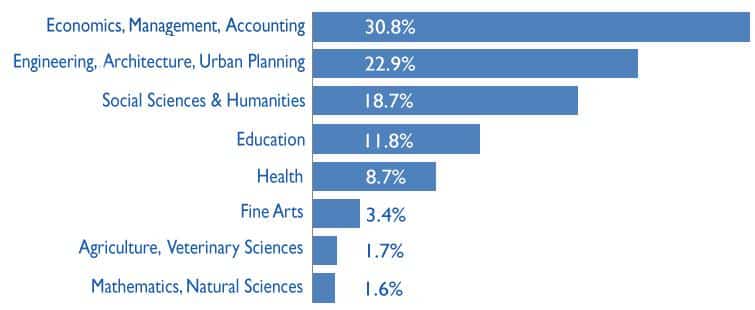Market Snapshot: Colombia
has noted in the past that Colombia is an important country in international education. Local indicators continue to point upward: the public education budget is set to increase, consumer spending on education is predicted to rise, demand for vocational training is growing, there is heightened interest in internationally recognised certifications, and, most importantly, study abroad and English language education demand is expanding.
Facts and figures
Let’s begin with a few facts about Colombia and its education sector to help frame this market profile:
- Population: 47.9 million;
- Rank on Global Competitiveness Index: 66 (up three spots from 2013);
- Number of public and private institutions: 304 and 2,212 respectively;
- Number of universities ranked in Latin America’s top 300: 42;
- Number of students enrolled in higher education, 2012: 1.8 million;
- Number that graduated in 2012: 241,049.
Colombia has four basic types of higher education institutions:
- Universities offering programmes leading to undergraduate degrees and sub-doctoral graduate degree in specific areas;
- Universities offering a full range of academic programmes, including doctorates;
- Professional technical institutions offering short-term postsecondary training in numerous vocational fields;
- Technological institutions offering high level training funneling directly to careers or upper level tertiary education.
At the moment, only 2% of Colombian tertiary students are enrolled abroad, but Colombia’s Ministry of Education has made academic mobility central to its overall education plan. With fiscal backing from the Colombian Institute of Educational Credit and Technical Studies Abroad (ICETEX), a determined effort is afoot to attract international scholars and students to Colombian universities, increase instruction provided in English, and assist Colombians studying abroad. The newly reelected government of Juan Manuel Santos, which began its new term in August, has for the first time made the public education sector (slated to receive US$14.52 billion in 2015) a larger fiscal item than military spending. “That’s never happened before,” Mr Santos said of his budget, “and it should be that way from now on.” He also talked about Colombia being recognised by 2025 as the best-educated country in Latin America. President Santos had already launched numerous first-term education initiatives designed to bring a global dimension to academic programmes, link internationalisation to accreditation processes, and mainstream second language requirements into school curriculum in order to increase second language competence. In order to achieve Santos’s lofty goals, Colombia will also need to improve its low level of English proficiency. At the moment, approximately 5% of the general population and about 60% of university professors speak English. The government rightly deems these rates a barrier to global competitiveness, and has embarked on a plan to increase English literacy among teachers and hopefully triple the number of students who speak the language at high proficiency.
Colombian mobility
Despite low overall English proficiency, when Colombians opt for overseas study they go in large numbers to English-speaking countries. UNESCO puts the total number of Colombian tertiary level students abroad at 23,602 in 2012, with more than 8,800 of them in the US, Australia, New Zealand, Canada, and the UK. The top ten destination countries for Colombian outbound mobility (again based on UNESCO data) are as follows:
- United States 6,097;
- Spain 5,855;
- France 2,979;
- Australia 1,245;
- Germany 1,238;
- Italy 995;
- United Kingdom 918;
- Chile 773;
- Canada 510;
- Cuba 454.
While all English-speaking countries are in demand, the prevalence of the Spanish language in the US is an advantage. Traditionally high, Colombian interest in studying in England has decreased recently due to work permit changes and the relatively high cost of living in the UK. Interest in study abroad opportunities in Canada, Australia, and New Zealand, meanwhile, are all on the rise. Possibly due to variances in methodology, the OECD gives a slightly different picture than UNESCO of Colombian mobility in its 2014 Education at a Glance report. It also leaves out non-OECD countries like Cuba, which is a top ten destination in UNESCO’s figures. Looking at the OECD’s calculated percentages of total Colombian tertiary students studying abroad reveals that 28.8% of all Colombian tertiary students who study overseas do so in Spain. Top ten countries are as follows:
- Spain 28.8%;
- United States 19.3%;
- France 9.4%;
- Canada 8.1%;
- Germany 5.0%;
- United Kingdom 4.8%;
- Chile 4.5%;
- Australia 3.9%;
- Switzerland 1.2%;
- Brazil 1.1%.
From the reverse perspective, the numbers of Colombians measured against the inbound total for various countries creates a picture of the importance of Colombian students to the international education programmes of those countries. For example, 22.3% of all mobile tertiary students in Chile come from Colombia. The top ten destinations by percentage of Colombian enrolment are as follows:
- Chile 22.3%;
- Spain 10.5%;
- Brazil 2.4%;
- Italy 1.3%;
- United States 0.8%;
- Switzerland 0.8%;
- Germany 0.7%;
- Australia 0.5%;
- Estonia 0.5%;
- Canada 0.4%;
- Sweden 0.4%.
Taken as whole, OECD figures show that nearly two-thirds of Colombian tertiary students are enrolled in only four countries - Spain, the US, France, and Canada. In the ESL sector, as expected the US, UK and Australia are top destinations, however Malta has increased in popularity in recent years, and more Colombians are choosing to study in Ireland than in the past.
Fields of study
In terms of preferred areas of study, the following chart shows the distribution of Colombian enrolment (both domestic and study abroad) from 2001 to 2012.

A closer look at international student recruitment
Some of our most current and detailed information on the international education market in Colombia comes from two studies: the British Council and English UK’s English Language Market Report: Colombia, and the Canadian government’s 2012 report The International Education Market in Colombia. Both focus on the burgeoning English language education sector, but both offer useful insights into the broader Colombian education market as well. (Editor's note: Neither report is publicly available online but the British Council/English UK report and the Canadian report can be accessed by those with the necessary login credentials.) The first point that comes through from these market studies is that Colombia is an agent-dependent education market. There are numerous large foreign agencies with multiple offices, as well as many smaller, local agents as well. Most large companies are based in the capital city of Bogotá, but in recent years smaller agents have set up in other Colombian cities. Larger Colombian agencies are tech savvy and well aware that large, modern headquarters packed with the latest digital gear are effective for projecting professionalism and trustworthiness. Concise, image-laden promotional loops are a common sight in these offices and generate good responses. Colombian students expect the same high levels of technical capability from foreign schools that reach out to them. But if technology can open the door, a personal touch is key to converting student interest into applications and enrolment. The British Council report, for example, reveals that swift responses to emails is of the highest value to prospective students, with market visits by schools coming in a close second. Colombian students often begin planning for overseas study more than a year in advance, and family members are closely involved. Successful interpersonal contact is important here as well. Since parents’ English proficiency is usually lower than that of prospective students, marketing information tailored toward Spanish speakers can influence those most likely to, in turn, influence prospective students. Other practical considerations and tips when working with prospective students and families include:
- Detailed information about room and board is key to help address any concerns about high costs of living abroad. Students might also require additional details about employment opportunities, safety, and culture in their intended destination country.
- Prospective language students typically make visits to multiple agencies. This means educational institutions working with various agencies in Colombia may receive applications from more than one agency for the same student.
- When time comes for payment, families prefer to do so through a local agency, as sending money out of the country is believed to be a risky endeavor. But in actuality, Colombian banking as it relates to international payments and foreign currency transfers is tightly regulated and complex, and local assistance with international transfers can be an important service for both students and receiving institutions.
- Colombia has mandatory military service commencing at age 18, and this can delay the entry of local students into tertiary education. However President Santos has suggested that if his government can reach a peace deal with FARC fighters (Revolutionary Armed Forces of Colombia) he will eliminate the service requirement.
Going forward
The country’s planned investments in education under the Santos administration, along with its continuing internationalisation efforts, suggest further potential for growth and international partnerships in education in the years ahead. This potential will no doubt be influenced by the effectiveness of the implementation of the government’s education initiatives, not to mention commodity prices in global energy markets, but Colombia continues to emerge as an important international education market in Latin America.


















